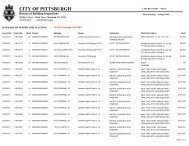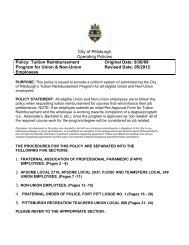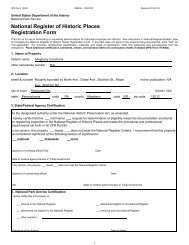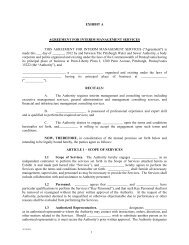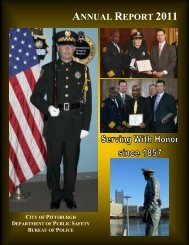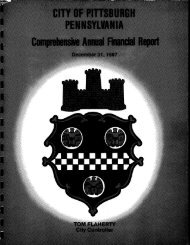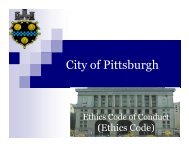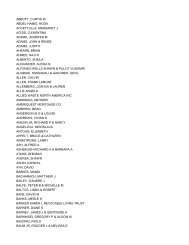east liberty station: realizing the potential - City of Pittsburgh
east liberty station: realizing the potential - City of Pittsburgh
east liberty station: realizing the potential - City of Pittsburgh
You also want an ePaper? Increase the reach of your titles
YUMPU automatically turns print PDFs into web optimized ePapers that Google loves.
IMPLEMENTING PREVIOUSLY IDENTIFIED<br />
INFRASTRUCTURE IMPROVEMENTS<br />
Numerous essential infrastructure needs<br />
have already been identified for East Liberty<br />
through past planning. In some cases, such<br />
as <strong>the</strong> Penn Circle Conversion, aspects <strong>of</strong><br />
<strong>the</strong>se projects have been implemented.<br />
Completing infrastructure improvements in<br />
<strong>the</strong> larger district is key to <strong>realizing</strong> <strong>the</strong> TOD<br />
<strong>potential</strong> in East Liberty and <strong>the</strong> creation <strong>of</strong><br />
a TRID can be a key mechanism for funding<br />
infrastructure improvements.<br />
ITS Infrastructure & Signalization<br />
Upgrades<br />
Traffic21 is a multi-disciplinary research<br />
initiative <strong>of</strong> Carnegie Mellon University.<br />
Its goal is to design, test, deploy and<br />
evaluate information and communications<br />
technology based solutions to address <strong>the</strong><br />
problems facing <strong>the</strong> transportation system<br />
<strong>of</strong> <strong>the</strong> <strong>Pittsburgh</strong> region.<br />
The <strong>Pittsburgh</strong> region will serve as a<br />
“learning lab,” deploying solutions that can<br />
be applied around <strong>the</strong> nation and <strong>the</strong> globe.<br />
Traffic21 will leverage Carnegie Mellon’s<br />
leadership in relevant areas such as critical<br />
infrastructure, transportation access,<br />
transportation routing, human factors,<br />
artificial intelligence, web applications and<br />
autonomous vehicles.<br />
One <strong>of</strong> Traffic 21’s initiatives is <strong>the</strong><br />
development <strong>of</strong> smart adaptive traffic<br />
signals. This includes technology that will<br />
allow traffic signals to communicate with<br />
each o<strong>the</strong>r and adapt to traffic in real time.<br />
A simulation model was developed for<br />
downtown traffic, and it has demonstrated<br />
that adaptive signals are effective and<br />
if even only a few lights can be made to<br />
adapt <strong>the</strong>ir signal patterns to changing<br />
conditions, substantial reductions in<br />
congestion can be achieved.<br />
A <strong>potential</strong> application <strong>of</strong> this technology<br />
could be to adjust traffic signals to<br />
prioritize routes around <strong>the</strong> TOD area and<br />
make better use <strong>of</strong> <strong>the</strong> larger roadway<br />
network. This could include roads such<br />
as Penn Circle West and North, Highland<br />
Avenue, Broad Street, Negley Run<br />
Boulevard, and East Liberty Boulevard.<br />
This technology can manage demand<br />
so that some <strong>of</strong> <strong>the</strong> through traffic is<br />
discouraged from using Penn Avenue,<br />
and directed to o<strong>the</strong>r routes. This would<br />
be advantageous to both <strong>the</strong> near-term<br />
intersection modification and <strong>the</strong> longerterm<br />
roundabout concepts.<br />
Coordinated Smart Parking District<br />
Currently parking in East Liberty is a<br />
mix <strong>of</strong> publicly owned and managed <strong>of</strong>fstreet<br />
surface lots, on-street metered<br />
parking, and private surface and garage<br />
parking some associated with large scale<br />
developments and individual businesses.<br />
Parking is inconsistently priced and<br />
underutilized. In accordance with TOD<br />
principles, parking should be managed with<br />
a coordinated district wide strategy. This<br />
should include improvements to existing<br />
parking resources such as <strong>the</strong> installation<br />
<strong>of</strong> shared pay <strong>station</strong>s for on-street parking<br />
and a coordinated graduated pay structure<br />
both on-street and <strong>of</strong>f-street parking.<br />
Mobile technology applications should also<br />
be employed to connect parking spaces<br />
to provide real-time parking availability<br />
information to incoming drivers. As new<br />
parking garages are constructed, strategies<br />
should be employed to created shared<br />
parking resources when possible. Finally<br />
provisions should be included for car<br />
sharing services and bicycle parking.<br />
Penn Avenue 2-Way Conversion<br />
To date two <strong>of</strong> <strong>the</strong> four sections <strong>of</strong> Penn<br />
Circle have been converted back to<br />
bidirectional traffic from <strong>the</strong> one-way loop<br />
implemented in <strong>the</strong> 1960s. While Penn<br />
Circle South and East have been converted<br />
81



